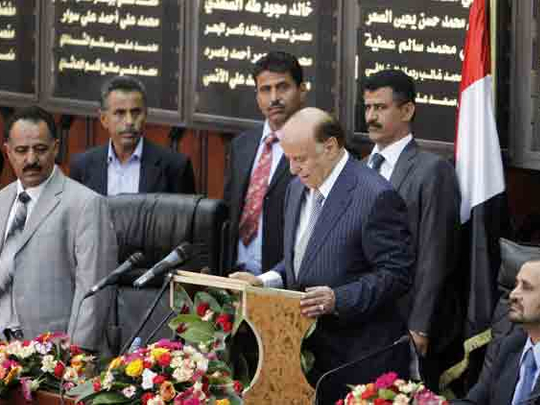
Among Arab Spring countries that witnessed revolutions, Yemen’s model was hailed by some as the least violent and the most effective in starting a peaceful transition from an authoritarian regime to a democracy.
Another unique characteristic in Yemen’s model is the National Dialogue Conference (NDC), through which rivals were allowed to discuss and settle scores peacefully instead of engaging in street violence.
Compared to the ongoing civil war in Syria and the turmoil in Egypt, Tunisia and Libya, Yemen’s model appears to have so far succeeded in keeping the country afloat.
Yet Yemen’s model is at risk of failing. There are many factors that could work against it.
The first factor is the fact that there is no plan B to fall back on if there is a political stalemate at the NDC. Despite all the praise lavished on the Yemeni model, it was certainly not wise to put everything in the NDC basket. In several of his public speeches, President Abd Rabbo Mansour Hadi stressed that those involved in the NDC have no choice, but to succeed in coming up with the deliverables, which include the new constitution, form of state, and various other strategic outputs that would shape the future of Yemen.
The second factor is the interference of former president Ali Abdullah Saleh and his loyalists, who remain actively engaged in politics via the General People Congress party. Hadi was vocal in expressing concern about the meddling of “those who lost their interests”, in what can be seen as an inference to Saleh’s regime. It is worth noting that Hadi had started restructuring the Yemeni army and security forces by dismissing Saleh’s sons and close relatives from their posts so as to minimise his influence. But that doesn’t mean that Saleh does not still possess enough power to destabilise the state by utilising connections and alliances he formed while in power for over 33 years. Saleh often warned that Yemen would disintegrate and fail if he transfers power. He might still have just enough influence to ensure that this prediction comes true.
The third factor is the dependence on foreign aid and lack of enough strategic options to support the economy. In 2011, Hadi had warned of what he called “a hunger revolution”. Two years later, it appears that the risk of such a revolution still exists, particularly with hundreds of thousands of Yemeni migrants being deported from Saudi Arabia and the frequent attacks on oil pipelines and other facilities, which are vital in supporting the economy with much-needed hard currency. Yemen is relying on donations and grants from Saudi Arabia and other ‘Friends of Yemen’ to meet day-to-day expenses and pay salaries. But this is certainly not sustainable and may weaken Yemen’s sovereign political will, particularly when it comes to major decisions that could anger some of those donor countries.
A fourth factor to consider is the security situation that has recently received a lot of press attention with the closure of several western embassies in Sana’a due to perceived threat from Al Qaida elements following a series of assassinations thought to be executed by radical elements. In the past, it was reported that Saleh used Al Qaida operatives to extort funds and support from other countries, which explains why some extremist groups in the south were allowed to flourish during the last phase of Saleh’s rule only to be crushed when Hadi came to power.
To confront ‘terrorism’, Hadi appears to have invested heavily in his security cooperation with the US, which he visited recently. Hadi’s approval of the US drone programme to target ‘extremists’ throughout Yemen has resulted in criticism by human rights advocates. They argue that such a programme is illegal as every citizen has the right to be tried in a court of law instead of being killed in such an extrajudicial manner. The angry public reaction to civilian deaths in drone strikes has put more pressure on Hadi to either abandon or minimise such cooperation.
There are also other factors that come into play, including the lack of basic services such as electricity and water, tribal conflicts, lack of proper methods to control the flow of weapons, etc.
To conclude, Yemen’s transition to democracy may indeed be unique and promising, but what needs to be emphasised is the fact that the transition is now in a critical stage and is not yet over. The coming weeks and months will show if it can survive these threats.
Only then can one confidently claim that the Yemeni model is indeed the right way to go about creating a democracy after decades of authoritarianism.
Walid Al Saqaf is founder and administrator of YemenPortal.net.









